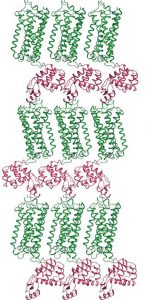New paper uncovers the structure of CB2, the second human cannabinoid receptor
Findings from an international group of researchers might help in the development of drugs against inflammatory and neurodegenerative diseases. Their paper, published in Cell, describes the crystal structure of the human cannabinoid receptor CB2.

Type 2 cannabinoid receptor crystal. Credit: Xiaoting Li et al./Cell.
Exploring the Endocannabinoid System
CB1 and CB2, two cannabinoid receptors, belong to the endocannabinoid system. CB1 receptors are commonly found in the human body’s nervous system, while CB2 receptors are mainly in the immune system. Previous research suggests that CB2 may be a promising immunotherapy target, and can also potentially be used to treat inflammatory and neuropathic pain, as well as neurodegenerative disease.
CB1 and CB2 are 44 percent identical by amino acid sequence, which can make it difficult to develop drugs that specifically target just one of the receptors. Up until now, the CB2 structure was unknown.
Gaining a Deeper Understanding of CB2
In the new paper, the team of researchers revealed the structure of CB2 using X-rays. The group developed a crystal made from CB2 receptors bound to molecules blocking this receptor. The goal was to not only see the structure of CB2, but also how it connects to antagonists.
Because receptors are naturally unstable, they first needed to be modified using gene engineering. The researchers turned to a software program that predicts mutations that can be useful for stabilizing receptor molecules.
From here, the researchers were able to compare the structure of CB2 to CB1. They concluded that substances that activate one of the receptors can either weaken or entirely inhibit the other, and vice versa.
“Every G protein-coupled receptor structure that is discovered has prospects for rational design of more efficient drugs,” study co-author Petr Popov of the Moscow Institute of Physics and Technology said in press release. “Now that the structures of both cannabinoid receptors are known, we can design selective compounds targeting only one of the receptors, as well as agents with a desired polypharmacological profile targeting both receptors at once.”
Do you work in this area of research? The Kerafast catalog includes a series of cannabinoid receptor cell lines from the lab of Dr. Ken Mackie at Indiana University:
- CB1 Cannabinoid Receptor Expressing HEK293 Cell Lines
- CB2 Cannabinoid Receptor Expressing HEK293 Cell Lines
- GPR55 Expressing HEK293 Cell Lines
You also might be interested in Opioid Receptor Antibodies from Icahn School of Medicine at Mount Sinai, or the Protein-Nucleic Acid Complex Crystal Screen from Wake Forest School of Medicine, used for solving structures via X-ray crystallography.


